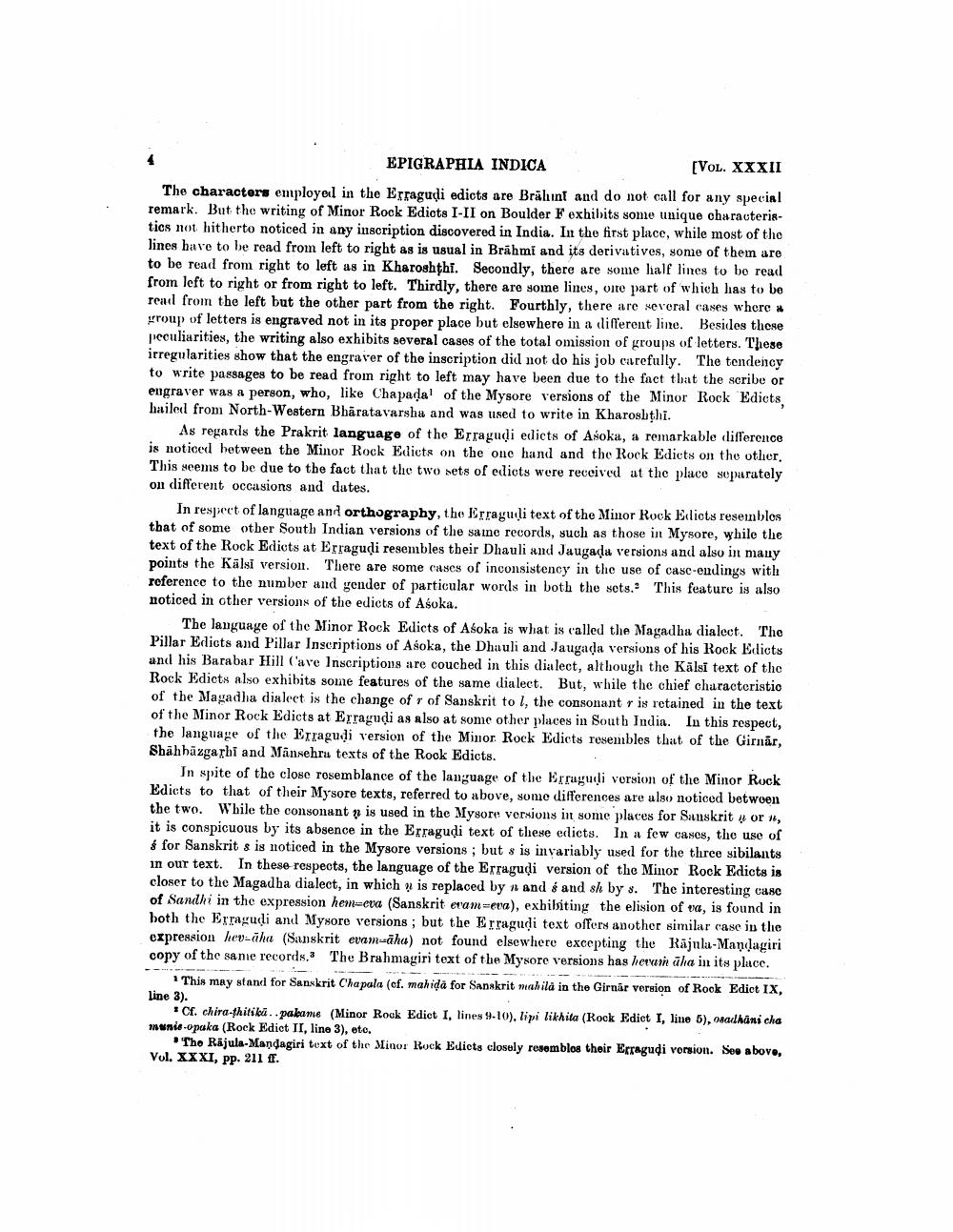________________
EPIGRAPHIA INDICA
(VOL. XXXII
The characters employel in the Eyragudi edicts are Brähnt and do not call for any special remark. But the writing of Minor Rock Edicts I-II on Boulder Fexhibits some unique characteristics not hitherto noticed in any inscription discovered in India. In the first place, while most of the lines have to be read from left to right as is usual in Brahmi and its derivativos, some of them are to be read from right to left as in Kharoshthi. Secondly, there are some half lines to be read from left to right or from right to left. Thirdly, there are some lines, oite part of which has to be read from the left but the other part from the right. Fourthly, there are several cases where * group of letters is engraved not in its proper place but elsewhere in a different line. Besides these peculiarities, the writing also exhibits several cases of the total omission of groups of letters. These irregularities show that the engraver of the inscription did not do his job carefully. The tendency to write passages to be read from right to left may have been due to the fact that the scribe or engraver was a person, who, like Chapadal of the Mysore versions of the Minor Rock Edicts, hailed from North-Western Bhäratavarsha and was used to write in Kharoshthi.
As regards the Prakrit language of the Erragudi edicts of Asoka, a remarkable difference is noticed between the Minor Rock Edicts on the one hand and the Rock Edicts on the other. This seems to be due to the fact that the two sets of edicts were received at the place separately on different occasions and dates.
In respect of language and orthography, the Errayutli text of the Minor Rock Edicts resembles that of some other South Indian versions of the saine records, such as those in Mysore, while the text of the Rock Ediots at Erragudi resembles their Dhauli and Jaugada versions and also in many points the Kälsi version. There are some cases of inconsistency in the use of case-endings with reference to the number and gender of particular words in both the sets. This feature is also noticed in other versions of the edicts of Asoka.
The language of the Minor Rock Edicts of Asoka is what is called the Magadha dialect. The Pillar Edicts and Pillar Inscriptions of Asoka, the Dhauli and Jaugada versions of his Rock Edicts and his Barabar Hill (ave Inscriptions are couched in this dialect, although the Kālsi text of the Rock Edicts also exhibits some features of the same dialect. But, while the chief characteristic of the Magadha dialect is the change of r of Sanskrit to I, the consonant r is retained in the text of the Minor Rock Edicts at Eyragudi as also at some other places in South India. In this respect, the language of the Erragudi version of the Minor Rock Edicts resembles that of the Girnar, Shahbāzgarhi and Mansehra texts of the Rock Edicts.
In spite of the close rosemblance of the language of the Erragudi version of the Minor Ruck Edicts to that of their Mysore texts, referred to above, some differences are also noticed betwoen the two. While the consonant » is used in the Mysore versions in some places for Sanskrit y or , it is conspicuous by its absence in the Erragudi text of these edicts. In a few cases, the use of $ for Sanskrit s is noticed in the Mysore versions ; but is invariably used for the three sibilants in our text. In these respects, the language of the Erragudi version of the Minor Rock Edicts is closer to the Magadha dialect, in which ạ is replaced by n and é and sh by 8. The interesting case of Sandhi in the expression hem-cva (Sanskrit eram=eva), exhibiting the elision of va, is found in both the Erragudi and Mysore versions ; but the Erragudi text offers another similar case in the expression hey-āha (Sanskrit eram-āha) not found elsewhere excepting the Rājula-Mandagiri copy of the same records. The Brahmagiri text of the Mysore versions has hervarin ūla in its place.
* This may stand for Sanskrit Chapala (cf. mahida for Sanskrit mahila in the Gimnár version of Rock Edict IX, line 3).
*Cf. chira-thitiku.. pabane (Minor Rock Edict I, lines 9-10), lipi likhita (Rock Edict I, line 5), osadhani cha wwwnie-opaka (Rock Edict II, line 3), eto.
The Rajula-Mandagiri text of the Minor Rock Edicts closely resemblos thoir Erragudi vorsion. Soo above, Vol. XXXI, pp. 211 ff.




